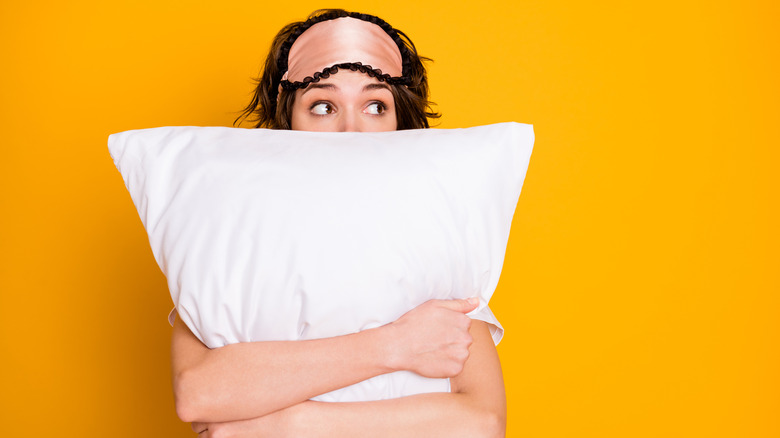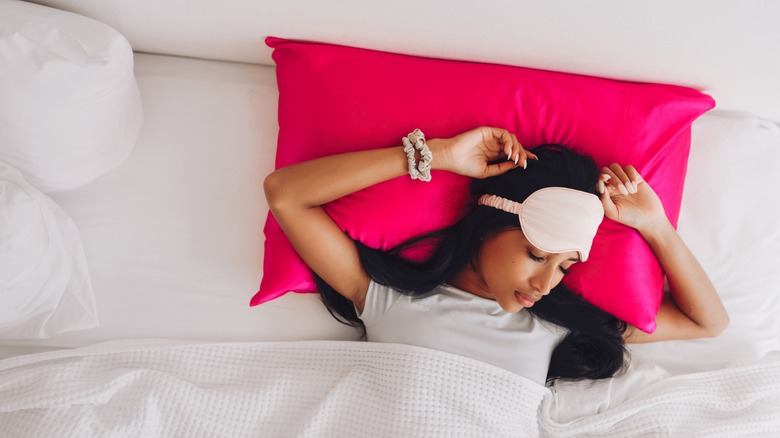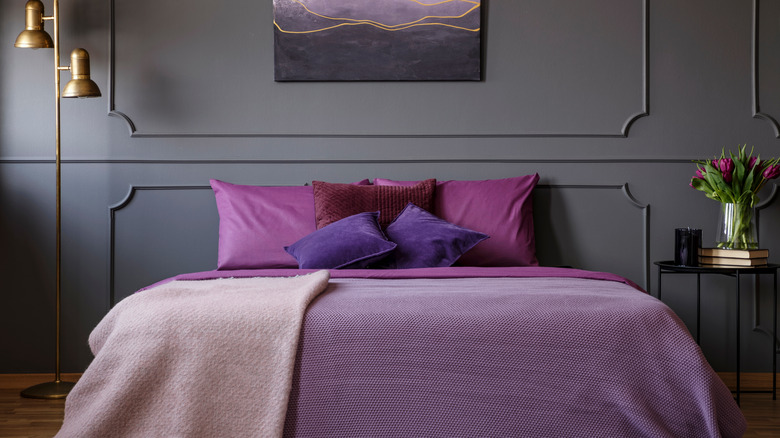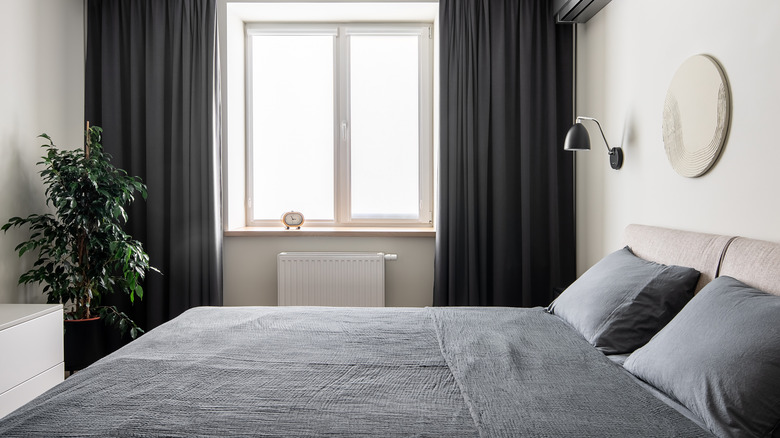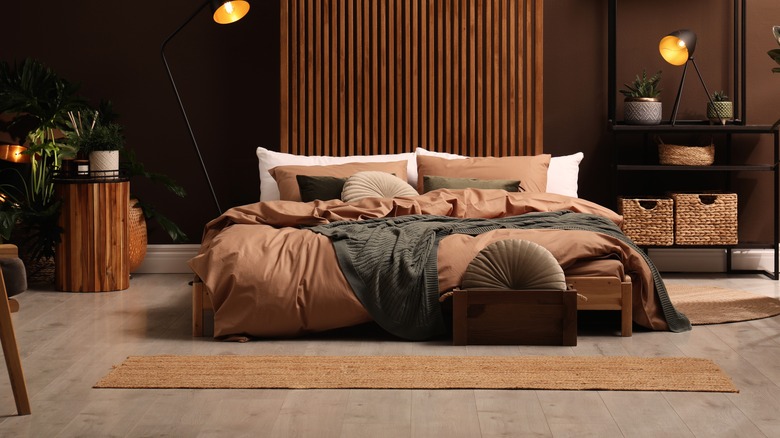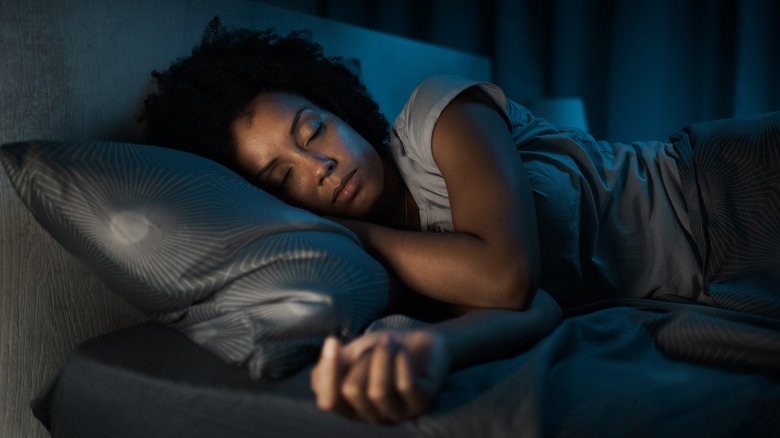Pillow Colors You Should Never Have In Your House
Most people have likely struggled with trouble sleeping at one point or another in their lives, but If you find yourself struggling to sleep at night on a regular basis your bedroom may actually be to blame.
While daily stressors related to work and relationships, caffeine intake, and certain mental health issues like anxiety and depression have all been proven to negatively impact your sleep (per the The National Health Service), research says that certain colors can as well. According to Healthline, because studies have shown that color can have an impact on mood, that means they can also play a major role in your quality of sleep.
Because your bedroom is the place you go to unwind after a long day, it's essential the environment you walk into is one that promotes relaxation and restful sleep. And while your bedroom is also arguably one of the best places in your house to experiment with colors that you might shy away from in more high-traffic spaces that are designated for entertaining, it's important to be mindful in ensuring that the colors you choose are conducive to a good night's sleep.
Throw pillows and bedding are an excellent way to work color into your space, but laying your head down on a pillowcase in certain shades might actually be ruining your chance at getting a restful sleep.
Red or bright pink
According to Amerisleep, red is an energizing color — so much so that it can actually increase your heart rate, making it difficult for you to fall asleep. Additionally, bright pink tends to be a bad choice for your pillow color due to its tendency to pull red when heavily saturated.
Sleep Foundation says that while you're sleeping, your heart rate should ideally be lower than it is while you're awake, as an increased heart rate can increase the time it takes your body to fall asleep. An increased heart rate is also associated with a lower quality of sleep once you do finally manage to drift off.
If you find yourself craving warm, rosy tones in your personal domain, Amerisleep recommends opting for something a little more subtle, like a pastel pink. The lighter shade will help you get your pink fix in without disrupting your sleep.
Bright purple
Because brighter purple shades have red undertones, Amerisleep says that they tend to evoke the same energizing feelings as red does. Therefore, it's best to avoid sleeping on bright purple pillows.
Not only does bright purple have a tendency to energize, it's also been shown to help boost creativity, which would normally be a positive attribute — unless you're trying to get some shut eye. Sleep expert Karen Yu tells Express that this is why it's smart to steer clear of purple colored pillows, as purple's ability to boost creative thinking work's against you when trying to turn off your brain and get an uninterrupted night of sleep.
For fans of purple, Amerisleep recommends choosing a pillow color in a more muted shade such as lavender due to its cool undertones that are more blue than red. Cooler tones can help you feel more relaxed and at peace as opposed to full of energy.
Dark gray
If you want neutral pillows, it's best to skip dark gray. According to Amerisleep, darker shades of gray can promote feelings of somberness and sadness due to the common association with a rainy and cloudy day. A depressed state of mind can negatively impact your sleep schedule and your ability to fall asleep, as mental health issues such as depression are commonly associated with insomnia — which is a symptom found in 75% of those who experience depression (per Johns Hopkins Medicine). Colors that promote these negative feelings are not an ideal choice for those who are already predisposed to mental health issues and who struggle with depression.
Instead of dark gray pillows, Amerisleep recommends incorporating the color thoughtfully into your bedroom by choosing a gray or even a silver that has blue undertones. Blue undertones can help gray hues feel less gloomy, and allow you to incorporate gray pillows into your bedroom color scheme in a way that doesn't promote negative vibes.
Brown
Brown is another neutral that is best avoided when picking out a color for your bedroom pillows. A study published in the National Library of Medicine found that similarly to the color gray, brown has been shown to subconsciously promote general feelings of gloom and can cause restlessness, making it difficult to fall asleep.
What's more, Karen Yu says via Express that brown pillowcases in your bedroom can make the room feel comfortless and lacking inspiration. It is best to avoid brown when choosing pillowcases and throw pillows for your bedroom.
If you naturally gravitate to earthy, neutral hues and want your bedroom pillows to reflect that, Amerisleep recommends choosing a warmer brown with orange undertones. Orange tones can warm up an otherwise flat brown and make it feel soothing and inviting, while darker, stark browns can feel lifeless and gloomy, making it very difficult to relax and unwind.
Black
Because black is the ultimate dark hue, many people associate it with sleep. The sky is black when we go to bed, and it's the color we see when we close our eyes at night — leading people to believe that the darker your room is, the easier it will be to fall asleep.
While it's easy to assume black and its absence of light and color distractions helps promote sleep, experts say it may have the opposite effect if not used sparingly in your design scheme — which means that black pillowcases and throw pillows might not be the best option for your bedroom if you struggle with sleep.
Because black in design is often viewed as suppressive and uninviting, commonly being associated with sadness and gloom, it can evoke subconscious feelings of sadness, ultimately impacting your sleep — perhaps even more so than gray and brown due to its even darker hue (per The Sleep Doctor).
Using the color sparingly can help add drama and sophistication to your bedroom in a way that doesn't overwhelm the space. Casper says that while black is fine when used in small amounts throughout your bedroom in accent objects like picture frames, candles, and even curtains, selecting it as the dominant color for your bedding and pillows might negatively impact your sleep.
